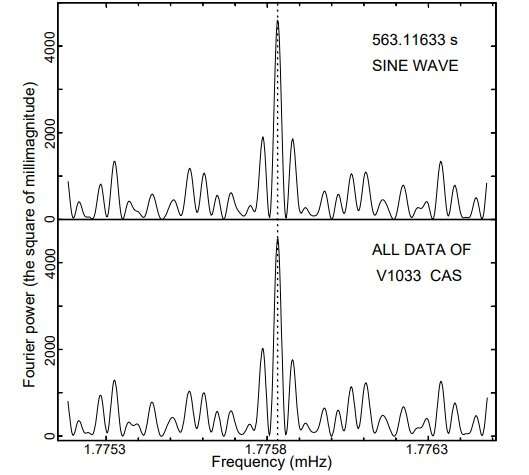November 25, 2019 report
Photometric study sheds more light on the properties of the intermediate polar V1033 Cas

Using the Kourovka Astronomical Observatory, Russian astronomers have conducted an extensive photometric study of the intermediate polar V1033 Cas (also known as IGR J00234+6141). Results of the new research, presented in a paper published November 15 on arXiv.org, provide more details about the properties of this peculiar system.
Cataclysmic variables (CVs) are binary star systems consisting of a white dwarf accreting material from a normal star companion. They irregularly increase in brightness by a large factor, then drop back down to a quiescent state. Polars are a subclass of cataclysmic variables distinguished from other CVs by the presence of a very strong magnetic field in their white dwarfs.
In some CVs, accretion occurs through a truncated accretion disc when the white dwarf is moderately magnetic. These systems are known as intermediate polars (IPs). Observations have shown that in IPs, the magnetic white dwarf spins asynchronously with the orbital period of the system and therefore produces a rapid oscillation with the spin period. Therefore, determining precise spin period and precise oscillation ephemeris could be the key to reveal the IP nature of some CVs.
It is supposed that V1033 Cas is an IP, however, no precise measurements have been conducted to date in order to confirm this. Now, a team of astronomers led by Valerij Kozhevnikov of the Ural Federal University in Russia, reports the results of an extensive photometric study of V1033 Cas, which deliver more insights into the properties of this CV, proving its IP nature. The data were obtained in 2017 with a multichannel pulse-counting photometer installed on the 70-cm telescope at Kourovka Astronomical Observatory.
"We performed extensive photometric observations of V1033 Cas over 34 nights. The total duration of observations was 134 hours. The observations covered 11 months," the astronomers wrote in the paper.
The observations allowed the team to measure the spin period of the white dwarf in V1033 Cas with high precision. This value was found to be approximately 563.11 seconds. Based on the spin period, the oscillation ephemeris was calculated to have long validity of 100 years.
According to the paper, the results confirm that V1033 Cas is an IP. However, the astronomers noted that the spin oscillation semi-amplitude was stable and was equal to 95.5 millimagnitude. This value is higher when compared to other intermediate polars with similar spin periods and suggests that V1033 Cas is noticeably inclined.
The study also detected orbital variations of V1033 Cas with a period of about 4.02 hours and with a semi-amplitude of 55 millimagnitude. This finding also suggests that the system is noticeably inclined and is compatible with the large amplitude of the spin oscillation.
In concluding remarks, it was noted that the finding of high stability of the spin period is very important because it contradicts the suggestion that the white dwarf in V1033 Cas is not spinning at equilibrium.
"Using this ephemeris and the times of spin pulse maximum obtained 10–11 years ago, we found that the spin period is very stable. dP/dt is most probably less than −4 × 10−12. This high stability contradicts the assumption that the white dwarf in V1033 Cas is not spinning at equilibrium," the researchers concluded.
More information: Extensive photometry of the intermediate polar V1033 Cas (IGR J00234+6141), arXiv:1911.06522 [astro-ph.SR] arxiv.org/abs/1911.06522
© 2019 Science X Network





















